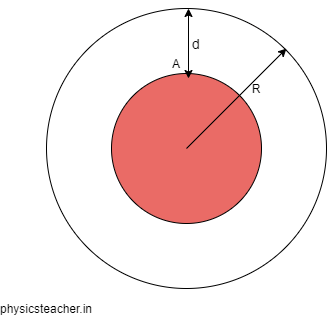Variation of g with height and depth – how g changes with height and depth
Last updated on April 23rd, 2022 at 02:38 pm
Variation of g with height and depth: Acceleration due to gravity or g varies as the height or depth varies with respect to the surface of the earth. This means the value of g on top of a mountain won’t be exactly the same as that on the earth’s surface. Similarly, g at a location considerably below the earth’s surface won’t be equal to the value of g on the earth’s surface. This is known as the variation of g with height and depth. Variation of g with height is expressed by the formula g1 = g (1 – 2h/R), where h<<R. And, the Variation of g with depth is expressed by the formula g2 = g (1 – d/R).
Here g1 is the acceleration due to gravity at a height of h with respect to the earth’s surface. And, g2 is the acceleration due to gravity at depth d with respect to the earth’s surface. R is the radius of the earth.
The extent of the variation of g with height differs from that of the variation of g with depth, but it’s to note that the value of g falls both with increasing height & with increasing depth, with respect to the earth’s surface. This also means the value of g is maximum on the surface of the earth itself.
Now, to discuss exactly how acceleration due to gravity changes with height and depth with respect to the surface of the earth, we will take the help of simple mathematics and analyze separately (1) the Variation of g with height and (2) the Variation of g with depth and derive the formulas describing this variation of g with altitude and depth.
[ Note: Here, the symbol g is used frequently and it means Acceleration due to gravity]
- Variation of g with height | How does Acceleration due to gravity(g) change with height?
- Variation of g with depth | How does Acceleration due to gravity(g) change with depth?
- Derive the Formula for acceleration due to gravity at height h | Variation of g with height derivation
- Derive the Formula for acceleration due to gravity at depth d | Variation of g with depth derivation
- FAQ – Frequently Asked Questions with Answers
Variation of g with height | How does Acceleration due to gravity(g) change with height?
Variation of g with height: As altitude or height h increases above the earth’s surface the value of acceleration due to gravity falls. This is expressed by the formula g1 = g (1 – 2h/R), where h<<R. Here g1 is the acceleration due to gravity at a height of h with respect to the earth’s surface and R is the radius of the earth.
So at a height h above the earth’s surface, the value of g falls by this amount: 2gh/R.
For example, considering g = 9.8 m/s^2 on the earth’s surface, g1 at a height of 1000 meters from the surface of the earth becomes 9.7969 m/s^2. [ check with online calculator ]
Formula for g at height h
The Variation of g with height is expressed by the formula g1 = g (1 – 2h/R), where h<<R. Here g1 is the acceleration due to gravity at a height of h with respect to the earth’s surface and R is the radius of the earth. This is the formula for g at height h.
Variation of g with depth | How does Acceleration due to gravity(g) change with depth?
Variation of g with depth: As depth d increases below the earth’s surface the value of acceleration due to gravity falls. This is expressed by the formula g2 = g (1 – d/R). Here g2 is the acceleration due to gravity at depth d with respect to the earth’s surface and R is the radius of the earth.
So at a depth d below the earth’s surface, the value of g falls by this amount: gd/R
For example, considering g = 9.8 m/s^2 on the earth’s surface, g2 at a depth of 1000 meters from the surface of the earth becomes 9.7984 m/s^2. [ check with online calculator ]
Formula for g at depth d
The Variation of g with depth is expressed by the formula g2= g (1 – d/R). Here g2 is the acceleration due to gravity at a depth of d with respect to the earth’s surface and R is the radius of the earth. This is the formula for g at depth d.
Derive the Formula for acceleration due to gravity at height h | Variation of g with height derivation
Derivation of g1 = g (1 – 2h/R) – step by step proof
We will derive the expression of g at a height h above the earth’s surface. This will show the variation of acceleration due to gravity with height.
This section covers the variation of g with altitude. At a height of h from the surface of the earth, the gravitational force on an object of mass m is: F = GMm/(R+h)2
Here (R + h) is the distance between the object and the center of the earth.
Say at that height h, the gravitational acceleration is g1.
So we can write, mg1 = GMm / (R+h)2
=> g1 = GM/(R+h)2 _________________ (1)
Now we know on the surface of the earth, it is
g = GM / R2 [ see the proof: equation of g on earth’s surface ]
Taking the ratio of these 2,
g1/g = R2 /(R+h)2
= 1/(1 + h/R)2 = (1 + h/R)-2 = (1 – 2h/R) [ with the assumption that h<<R]
so, g1/g = (1 – 2h/R)
The Formula for the acceleration due to gravity at height h is represented with this equation:
=> g1 = g (1 – 2h/R) ______(2) [ with the assumption that h<<R]
g1 is the acceleration due to gravity at height h.
Derive the Formula for acceleration due to gravity at depth d | Variation of g with depth derivation
Derivation of g2 = g (1 – d/R) – step by step proof
We will derive the expression of g at a depth d below the earth’s surface. This will show us the variation of acceleration due to gravity with depth.
Let’s say, a body of mass m is resting at point A, where A is at a depth of d from the earth’s surface.
The distance of point A from the center of the earth = R – d,
where R is the radius of the earth.

Mass of inner sphere = (4/3). Π. (R-d)3. ρ
Here ρ is the density. and Π is 22/7.
Now at point A, the gravitational force on the object of mass m is
F = G M m/ (R-d)2
= G. [(4/3). Π. (R-d)3. ρ] m/(R-d)2
= G. (4/3). Π. (R-d). ρ. m
Again at point A, the acceleration due to gravity (say g2) = F/m = G. (4/3). Π. (R-d). ρ _________________ (7)
Now we know at the earth’s surface, g = (4/3) Π R ρ G ( see the proof here: g formula on the surface of the earth using density)
Taking the ratio, again,
g2/g
= [G. (4/3). Π. (R-d). ρ ] / [(4/3) Π R ρ G]
= (R-d) / R = 1 – d/R.
=> g2 = g (1 – d/R)
The formula for the acceleration due to gravity at depth d is represented with this equation:
=> g2 = g (1 – d/R) ______ (8)
g1 is the acceleration due to gravity at a depth of d
FAQ – Frequently Asked Questions with Answers
What is the variation in acceleration due to gravity with altitude?
g1 = g (1 – 2h/R)
This gives the formula for g at height h, [ with the assumption that h<<R]
So as altitude h increases, the value of acceleration due to gravity falls. This describes the variation of g with height or altitude.
What is the change in the value of g at a height h?
g1 = g (1 – 2h/R)
This g1 gives the formula for g at height h, with the assumption that h<<R.
So the value of g will decrease by this amount: 2hg/R, at a height h above the earth’s surface. R is the radius of the earth.
What is the variation in acceleration due to gravity with depth?
g2 = g (1 – d/R)
This gives the formula for g at depth d.
So as depth d increases below the earth’s surface, the value of g falls.
What is the change in the value of g at a depth d?
g2 = g (1 – d/R)
This gives the formula for g at depth d.
So at a depth d below the earth’s surface, the value of g falls by this amount: gd/R. R is the radius of the earth.
In the next paragraph, we will compare these 2 equations to get a clearer picture.
How Acceleration due to gravity changes with height and depth? Equations – formula- Comparison
Let’s summarize how acceleration due to gravity changes with height and depth.
The formula for the acceleration due to gravity at height h (showing Variation of g with altitude)
g1 = g (1 – 2h/R)
at a height h from the earth’s surface, with the assumption that h<<R
The formula for g at depth h (showing Variation of g with depth)
g2 = g (1 – d/R)
at a depth d below the earth’s surface
1) Now from the equations, we see that both g1 and g2 are less than g on the earth’s surface.
That means acceleration due to gravity is maximum at the surface of the earth.
2) We also noticed that, g1 < g2
And that means:
1) the value of g falls as we go higher or go deeper.
2) But it falls more when we go higher.
3) It is also clear that acceleration due to gravity is maximum at the earth’s surface.
What is the value of acceleration due to gravity at the center of the earth?
At the center of the earth, the depth from the earth’s surface is equal to the radius of the earth.
So we have to put d = R in the equation g2 = g (1 – d/R)
Therefore the value of g at the center of the earth
is g (1- d/R) = g (1 – R/R)
=g (1-1) = 0
So we can see, that the value of g at the center of the earth equals zero.
Numerical Problems (based on the variation of g)
Q1: What is the value of g at a height 4 miles above the earth’s surface? The diameter of the earth is 8000 miles. g at the surface of the earth = 9.8 m/s2
See Solution
Q2: At what depth under the earth’s surface, the value of g will reduce by 1% with respect to that on the earth’s surface?
See Solution
Q3: If the value of g at a small height h from the surface equals the value of g at a depth d, then find out the relationship between h and d.
See Solution

